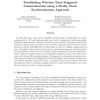Free Online Productivity Tools
i2Speak
i2Symbol
i2OCR
iTex2Img
iWeb2Print
iWeb2Shot
i2Type
iPdf2Split
iPdf2Merge
i2Bopomofo
i2Arabic
i2Style
i2Image
i2PDF
iLatex2Rtf
Sci2ools
WISES
2008
2008
Establishing wireless time-triggered communication using a firefly clock synchronization approach
In South-East Asia, huge swarms of fireflies synchronously emit light flashes to attract mating partners. The underlying principle can be used to implement a robust and scalable distributed synchronization approach in wireless sensor networks. This paper describes the adaption of this principle for wireless sensor networks using battery-powered low-cost nodes based on an off the shelf IEEE 802.15.4 MAC layer in order to establish a global notion of time. This global notion of time is the basis for a wireless time-triggered network protocol, but also provides a service that can be used by real-time applications. The time-triggered behavior enables the implementation of an energy-efficient protocol, where sender and receiver units can be turned off during silent phases. The approach is evaluated by simulation and a real world case study using AVR R Z-LinkTM802.15.4/ZigBee nodes. Results exploring various network topologies, parameter choices, and realistic clock source deviations show t...
Embedded Systems | Global Notion | Wireless Sensor Networks | Wireless Time-triggered Network | WISES 2008 |
| Added | 30 Oct 2010 |
| Updated | 30 Oct 2010 |
| Type | Conference |
| Year | 2008 |
| Where | WISES |
| Authors | Robert Leidenfrost, Wilfried Elmenreich |
Comments (0)

